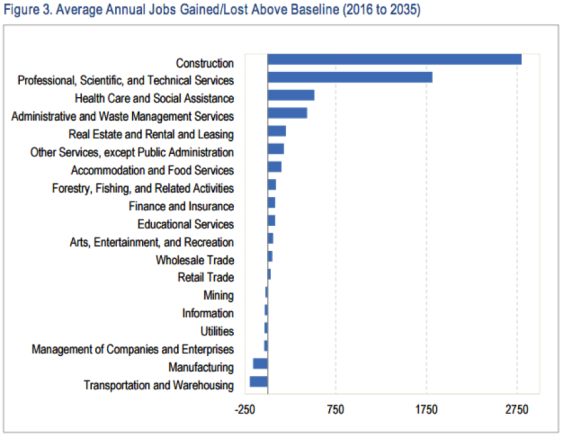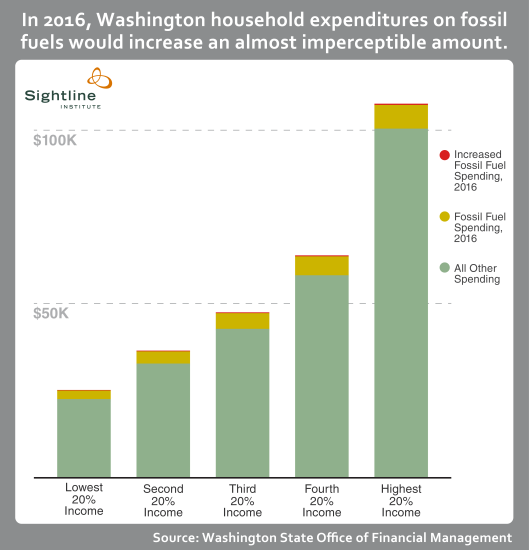As the Carbon Pollution Accountability Act, now HB 1314, wends its way through committee hearings, new economic analysis and revised revenue estimates are popping up. It’s still the same pollution-cutting, clean-energy-spurring bill you know and love, but the new numbers show it will send even more money to Washington public schools, and it will also grow jobs. Less pollution, more clean energy, better schools, and more jobs. I think that qualifies as awesome.
Less pollution means more GDP and more jobs, especially construction jobs.
Last week, the Office of Financial Management (OFM) and the Governor’s office presented findings from OFM’s new economic analysis of the Carbon Pollution Accountability Act, Washington HB 1314. The OFM economic modeling, unsurprisingly, showed results similar to Oregon’s recent modeling of a potential state carbon tax: GDP and jobs grow slightly faster in a future where Washington transitions from fossil fuels to clean energy than in a future where we continue with pollution-as-usual. The differences are small, because the pollution-limiting program would be a minuscule 0.3 percent of Washington’s gross state product of $381 billion. But GDP and jobs are a little higher with the polluters-pay than without, due to investments in schools and roads. The biggest job gains between 2016 and 2035 would be in the construction sector (see OFM graph below), since a large chunk of the pollution revenue would go to building and maintaining Washington’s roads.

Jobs Gains and Losses by OFM
The revenue will not run out.
Assuming pollution prices start at $12.90 per ton in 2016 and slowly rise to $44 per ton in 2035, total revenue will start at $1.3 billion in fiscal year 2017 and increase to $3.2 billion in 2035. Prices have to keep rising in order to drive pollution downward (orange line in graph below), so revenue (green bars in graph below) increases for decades.

Projections of revenue and pollution by Governor’s Office (Used with permission)
More money for schools
Increased projected revenue plus HB 1314’s slight adjustments to the amount of revenue going to each category means the revenue pie chart (below) looks a little different than when the Act was first proposed. Most of the money still goes to K-12 public schools and transportation, but now there is even more money for schools: an estimated $517 million in the first year. Half a billion would go part of the way to meeting the legislature’s court-mandated education funding requirements.

Original Sightline Institute graphic, available under our free use policy.
In the first year, households would see a tiny bump in fossil fuel expenditures.
OFM’s economic analysis modeled the fossil fuel cost impact on households at different income levels. As fossil fuel companies pass on the cost of their pollution permits to customers, fossil fuel prices would rise: gasoline would go up about 12 cents per gallon, and electricity up about half a cent per Kwh. In the first year of the pollution program, 2016, the lowest income households would pay about $144 per year more for fossil fuel energy. However, because some of the pollution-permit revenue would fund a Working Family Tax Credit of $223 per household, many of the lowest-income families would completely recoup their costs.
Of course, the point of transitioning off fossil fuels is that Washington households will ultimately spend less of their money on fossil fuels. In the first year, households will see a very tiny—0.36 to 0.65 percent (orange area in chart below)—increase in annual expenditures due to increased fossil fuel costs. But as time goes on and Washington weakens fossil fuels’ stranglehold on the economy, household spending on fossil fuels will decrease.

Original Sightline Institute graphic, available under our free use policy.
Refineries, not fuel distributors, will purchase permits.
HB 1314 makes refiners, rather than fuel distributors, purchase permits. Since there are fewer refineries, fewer than 100 facilities will likely need to purchase pollution permits. This new estimate is down from the previous list of up to 130 facilities. There are several facilities right on the cusp of the 25,000 million metric tons cut-off, so the exact number of facilities is hard to pin down. But the bill would update Washington’s existing reporting requirements for large facilities in order to get more clarity on who is in and who is out before the program moves forward.
OFM carefully ran the numbers and found that making polluters pay and reinvesting the money in Washington would trim pollution, grow jobs and the economy, fund schools, maintain roads, while holding working families and vulnerable businesses harmless. You don’t find deals like that very often!








Benoit St-Jean
READY and HOPING for YOU to contribute to a truly North American Carbon mkt !
The California / Québec Cap&Trade linkage system, under the Western CLimate Initiative Regional Carbon market, is ready, functional and eager to accept new serious partners like Oregon, Washington and Ontario, to confirm and consolidate a truly, efficient North American regulated carbon market.
Benoit St-Jean, baa, aci, ll.m.(environnement)
Conseiller en commerce international et changements climatiques
Advisor in International Commerce and Climate Change
Asesor en comercio internacional y cambio climático
St-jean.Benoit.2@courrier.uqam.ca, @GoEcoSynergie
James Adcock
This Inslee bill puts a price of $13/ton on carbon pollution. But real climate scientists (publishing recently in Nature Climate Change) put the real price of carbon pollution closer to $100/ton. Placing a tax on carbon only makes a difference if that tax is high enough to actually change behavior. Such a price is around $30-$40 a ton — a price high enough to change the behavior of our electrical utilities. Even then a price of (equivalently) $0.30 to $0.40 per gallon of gas isn’t going to change car driver behavior. Compare the Inslee bill to the CarbonWA approach — which has a price/ton 2X higher — still way too low to be effective — but a least it would be a start!
Frank John
I agree.
The point is to get the polluters to stop polluting — and the sooner the better. There is no point in giving residents of Oregon money to compensate for the pollution. The whole point is to stop pollution, because if you don’t, you and your children won’t be around to collect the money anyway.
I don’t understand why people cant see that.
Christin
I think this might be a rock and a hard place issue…
The rock: many people continue their willful ignorance about climate change so passing any laws limiting carbon has been a ridiculously long battle (it’s 2015, we have a 2020 deadline to get to 1990 levels and we haven’t passed any limits yet, essentially wasting 7 of the 12 years we gave ourselves). The willful ignorance often comes from fear about not being able to maintain one’s lifestyle or hobbies, due to the increased price of carbon.
The hardplace: we have to limit carbon somehow and the longer we continue to wait for the perfect bill for everyone to agree on the more severe the required changes will be. Since passing something that will hurt enough for people to change behaviors, isn’t likely to pass in our corrupted democracy… do we really have the time to wait to get anti-corruption candidates into all the offices (at the state level) before implementing a carbon limit?
Not to mention the state could really use the money right now so we can fully fund education (without eliminating higher education).
Perhaps an additional carbon use tax will be needed in the future to drive carbon reliance down more, but for now, I’m glad they’re even considering a decent proposal to put limitations on it.
Kenneth Carpenter
Has anyone warned God about the troublesome volcanos, or petitioned God to limit the CO2 from these sources? It is a fact that volcanos emit orders of magnitude more CO2 than we humans.